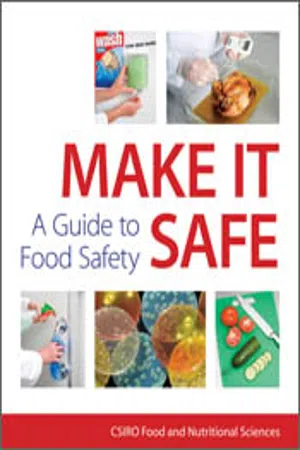
- 296 pages
- English
- ePUB (mobile friendly)
- Available on iOS & Android
About this book
All people involved with preparation of food for the commercial or retail market need a sound understanding of the food safety risks associated with their specific products and, importantly, how to control these risks. Failure to control food safety hazards can have devastating consequences for not only the consumer, but also the food manufacturer.
Make It Safe provides practical guidance on how to control food safety hazards, with a specific focus on controls suitable for small-scale businesses to implement.
Small businesses make up around two-thirds of businesses in Australia's food and beverage manufacturing industry. This book is aimed at those small-scale businesses already in or considering entering food manufacture. Those already operating a small business will develop a better understanding of key food safety systems, while those who are in the 'start-up' phase will gain knowledge essential to provide their business with a solid food safety foundation while also learning about Australian food regulations relevant to food safety. The content will also be useful for students studying food technology or hospitality who wish to seek employment in the manufacturing industry or are planning on establishing their own manufacturing operation.
Illustrated in full colour throughout, Make It Safe outlines the major food safety hazards – microbial, chemical and physical – which must be controlled when manufacturing all types of food products. The control of microbial hazards is given special emphasis as this is the greatest challenge to food manufacturers. Topics covered include: premises, equipment, staff, product recipes, raw ingredients, preparation, processing, packaging, shelf-life, labelling and food recalls. Key messages are highlighted at the end of each chapter.
Frequently asked questions
- Essential is ideal for learners and professionals who enjoy exploring a wide range of subjects. Access the Essential Library with 800,000+ trusted titles and best-sellers across business, personal growth, and the humanities. Includes unlimited reading time and Standard Read Aloud voice.
- Complete: Perfect for advanced learners and researchers needing full, unrestricted access. Unlock 1.4M+ books across hundreds of subjects, including academic and specialized titles. The Complete Plan also includes advanced features like Premium Read Aloud and Research Assistant.
Please note we cannot support devices running on iOS 13 and Android 7 or earlier. Learn more about using the app.
Information
Chapter 1
Why is food safety your concern?
What are the food safety hazards you should know about?
Microbial hazards
Term | Definition | Example |
Hazard | Source of harm | Wet slippery floor (due to water leak) |
Risk | Likelihood of being exposed to hazard and the likelihood of being harmed if exposed | Low risk – wet floor is in the corner of an unused room High risk – wet floor is in a poorly lit area that many people walk through |
Control measures | The actions that can be taken to reduce the risk of exposure or fully eliminate the hazard | Reduce risk – wet floor warning sign is placed in front of area Eliminate hazard – leak is fixed and water is mopped up |
Chemical hazards
Physical hazards
Table of contents
- Cover
- Title
- Copyright
- Contents
- Important notice concerning the information in this book
- Preface
- Chapter 1 Why is food safety your concern?
- Chapter 2 Food safety hazards – under the spotlight
- Chapter 3 Controlling food safety hazards – premises and people
- Chapter 4 Controlling food safety hazards – your product recipes
- Chapter 5 Controlling food safety hazards – your ingredients
- Chapter 6 Controlling food safety hazards – preparing, cooking and cooling safely
- Chapter 7 Controlling food safety hazards – packaging, shelf-life and labelling
- Chapter 8 What if something goes wrong?
- Chapter 9 Food microbiology: further facts
- Sources of information
- Useful contacts
- Glossary